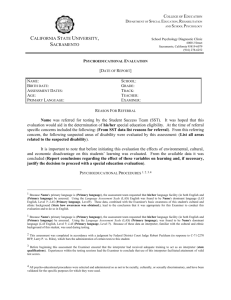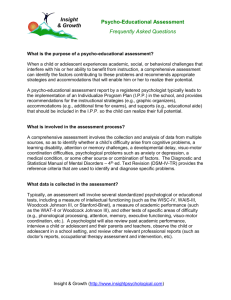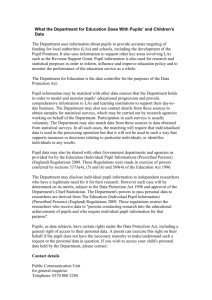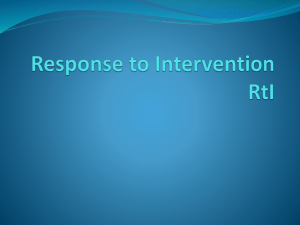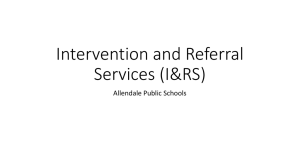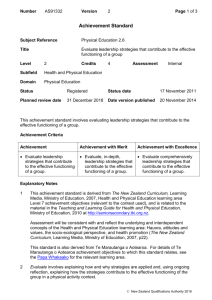PSYCHOEDUCATIONAL EVALUATION
advertisement
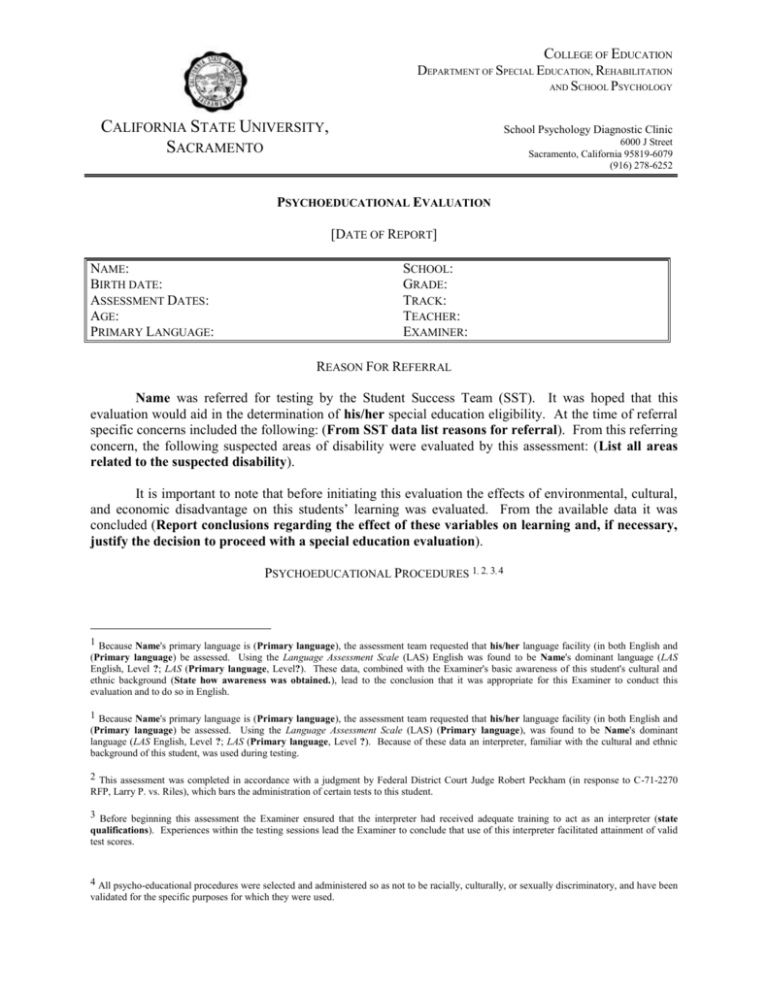
COLLEGE OF EDUCATION DEPARTMENT OF SPECIAL EDUCATION, REHABILITATION AND SCHOOL PSYCHOLOGY CALIFORNIA STATE UNIVERSITY, SACRAMENTO School Psychology Diagnostic Clinic 6000 J Street Sacramento, California 95819-6079 (916) 278-6252 PSYCHOEDUCATIONAL EVALUATION [DATE OF REPORT] NAME: BIRTH DATE: ASSESSMENT DATES: AGE: PRIMARY LANGUAGE: SCHOOL: GRADE: TRACK: TEACHER: EXAMINER: REASON FOR REFERRAL Name was referred for testing by the Student Success Team (SST). It was hoped that this evaluation would aid in the determination of his/her special education eligibility. At the time of referral specific concerns included the following: (From SST data list reasons for referral). From this referring concern, the following suspected areas of disability were evaluated by this assessment: (List all areas related to the suspected disability). It is important to note that before initiating this evaluation the effects of environmental, cultural, and economic disadvantage on this students’ learning was evaluated. From the available data it was concluded (Report conclusions regarding the effect of these variables on learning and, if necessary, justify the decision to proceed with a special education evaluation). PSYCHOEDUCATIONAL PROCEDURES 1, 2, 3, 4 1 Because Name's primary language is (Primary language), the assessment team requested that his/her language facility (in both English and (Primary language) be assessed. Using the Language Assessment Scale (LAS) English was found to be Name's dominant language (LAS English, Level ?; LAS (Primary language, Level?). These data, combined with the Examiner's basic awareness of this student's cultural and ethnic background (State how awareness was obtained.), lead to the conclusion that it was appropriate for this Examiner to conduct this evaluation and to do so in English. 1 Because Name's primary language is (Primary language), the assessment team requested that his/her language facility (in both English and (Primary language) be assessed. Using the Language Assessment Scale (LAS) (Primary language), was found to be Name's dominant language (LAS English, Level ?; LAS (Primary language, Level ?). Because of these data an interpreter, familiar with the cultural and ethnic background of this student, was used during testing. 2 This assessment was completed in accordance with a judgment by Federal District Court Judge Robert Peckham (in response to C-71-2270 RFP, Larry P. vs. Riles), which bars the administration of certain tests to this student. 3 Before beginning this assessment the Examiner ensured that the interpreter had received adequate training to act as an interpreter (state qualifications). Experiences within the testing sessions lead the Examiner to conclude that use of this interpreter facilitated attainment of valid test scores. 4 All psycho-educational procedures were selected and administered so as not to be racially, culturally, or sexually discriminatory, and have been validated for the specific purposes for which they were used. Name 2 Psycho-Educational Evaluation The following procedures were used to obtain a valid estimate of Name's psycho-educational functioning: [Traditional assessment procedures] In analyzing these results it needs to be kept in mind that the tests listed above were generally standardized on (standardization sample, e.g., monolingual English-speaking children). Thus, for the purposes of special education placement, the scores are psychometrically invalid. Children with Name's characteristics were not included in the test's standardization samples. The test scores do not necessarily indicate the presence of learning difficulties. However, they do give information regarding Name's present level of functioning in the English-speaking classroom. These scores can be used for baseline and follow-up measures to assess progress in English. Test scores alone should not be used to justify placing Name into special education. Alternative assessment procedures used during this assessment included the following: [Alternative assessment procedures] BACKGROUND INFORMATION Data obtained from Name’s cumulative folder indicates (Report the student’s achievement levels, grade-level changes/retentions, discipline records, work habits, prior special program placements, prior referrals, number of schools attended, attendance record, and learning strengths and weaknesses.) Program Modifications Educational interventions already attempted to meet Name's educational needs within a less restrictive environment have included the following: (e.g., specialist consultations, support services, minimum day, independent study, home teaching, suspension, alternate instructional methods, parent conferences/communication, etc.). At this time, these modifications have/have not allowed Name to be successful in the general education program. The following social interventions have been attempted: [When appropriate list interventions (e.g., counseling) and their duration. Describe the outcome of these interventions]. The following specific behavior interventions have been attempted: (When appropriate list behavioral interventions and their duration. Describe the outcome of these interventions). Developmental and Health History Pregnancy and birth history. During the parent interview Name's mother/father/stepmother/step-father (Parent's Name) indicated that (Describe pregnancy and birth history). There are/were no reports of substance abuse during pregnancy, or oxygen depravation at the time of delivery. Name was born at term/premature at (Number of weeks gestation) weeks gestation. Labor lasted (Length of labor) hours. Birth weight was (Birth weight). Problems reported to have occurred during the delivery included (Problems during delivery. In particular note anoxia during birth.). Birth weight was (Birth Weight). One and five minute Apgar scores were (1 Min. Score) and (5 Min. Score) respectively. Name 3 Psycho-Educational Evaluation Major developmental milestones. Developmental milestones are reported to have been (Report milestones). Health history. According to (Data source), prior to his/her diagnosis with (chronic or acute health problem), Name’s health history was (Describe history). Recent school screenings (Date) suggest (Vision) vision and (hearing) hearing. Family history. During the parent interview it was reported that there was no history of family members with learning or behavior difficulties During the parent interview it was reported that there was a history of other cases of attention deficit disorder and/or learning disabilities within the family. During the parent interview it was reported that there was a history of other family members with serious psychiatric disorders (e.g., schizophrenia or major depression). Previous Assessment Findings Name was previously assessed in (Date of previous testing) by (Examiner). Results suggested (Results). BEHAVIORAL ASSESSMENT Adaptive Behavior Behavior Ratings Behavioral Observations Classroom. Playground. Home. Test Taking Behavior. PSYCHOMETRIC ASSESSMENT Intellectual Ability Academic Functioning Name 4 Psycho-Educational Evaluation Language Functioning Social and Emotional Functioning SUMMARY AND EDUCATIONAL IMPLICATIONS Name is a (CA) (Grade) grade (Gender) who has been assessed to help determine his/her eligibility for special education assistance. At the time of referral specific concerns included (Reasons for Referral). Educationally relevant health and developmental findings include (Discuss relevant findings). Environmental, cultural, and/or economic disadvantage have (Discuss how these variables effect educational performance). Name’s second language acquisition has affected his/her learning (If appropriate discuss how language acquisition has influenced performance. Learning strengths would appear to include.... Learning weakness include.... Name’s academic functioning would appear to be affecting his/her social functioning in the following ways: (Describe this relationship). From the current battery of tests the following recommendations are made: 1. From this assessment it would appear that Name meets eligibility criteria as an individual with exceptional needs. It would appear that these needs cannot be corrected without special education assistance. Specifically, Name has significantly below average general intellectual functioning existing concurrently with deficits in adaptive behavior and manifested during the developmental period, which adversely affect a his/her educational performance. 1. Name does not appear to meet eligibility criteria as an individual with mental retardation [according to the California Code of Regulations - Title 5, Division 1, Chapter 3, Handicapped Children, Article 3.1, Section 3030 (h)]. This conclusion is based upon the following assessment finding(s): (a) Name was not found to have significantly below average general intellectual functioning. (b) Name was not found to have significantly below average adaptive behavior. (c) The effect of the documented disability would not appear to limit Name’s ability to benefit from general education program instruction. Name 5 Psycho-Educational Evaluation (d) Name’s learning difficulties appear to be primarily due to environmental disadvantage. (e) Name’s learning difficulties appear to be primarily due to cultural disadvantage. (f) Name’s learning difficulties appear to be primarily due to economic disadvantage. (g) Name’s learning difficulties appear to be primarily due to a lack of English proficiency (h) The available date suggests that a lack of instruction in (reading and/or math) plays a primary role in Name’s learning difficulties.”. 2. Additional areas of suspected disability not addressed in by the current assessment include the following: From this observation the following additional assessments are recommended: (List additional assessments that are judged required to address all areas of suspected disability, e.g., physical therapy, occupational therapy, recreational therapy, psychotherapy, etc. NOTE: the IEP meeting should not be held until these areas are assessed). 3. Specific interventions recommended to address Name’s anticipated learning needs include the following: a) b) 4. 5. The final decision as to whether or not Name meets special education eligibility will be made by the individualized education program team, including assessment personnel, and will take into account all relevant material which is available on Name. No single score or product of scores, test or procedure has been used as the sole criterion for the decision of the individualized education program team as to his/her eligibility for special education. _________________________________ Stephen E. Brock, Ph.D., NCSP Licensed Educational Psychologist Name 6 Psycho-Educational Evaluation 5 CCR 3030 - Eligibility Criteria A pupil shall qualify as an individual with exceptional needs, pursuant to Section 56026 of the Education Code, if the results of the assessment as required by Section 56320 demonstrate that the degree of the pupil's impairment as described in Section 3030 (a through j) requires special education in one or more of the program options authorized by Section 56361 of the Education Code. The decision as to whether or not the assessment results demonstrate that the degree of the pupil's impairment requires special education shall be made by the individualized education program team, including assessment personnel in accordance with Section 56341(d) of the Education Code. The individualized education program team shall take into account all the relevant material which is available on the pupil. No single score or product of scores shall be used as the sole criterion for the decision of the individualized education program team as to the pupil's eligibility for special education. The specific processes and procedures for implementation of these criteria shall be developed by each special education local plan area and be included in the local plan pursuant to Section 56220(a) of the Education Code. a. A pupil has significantly below average general intellectual functioning existing concurrently with deficits in adaptive behavior and manifested during the developmental period, which adversely affect a pupil's educational performance.
